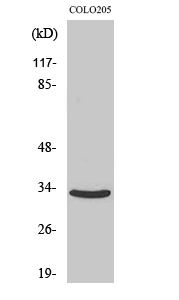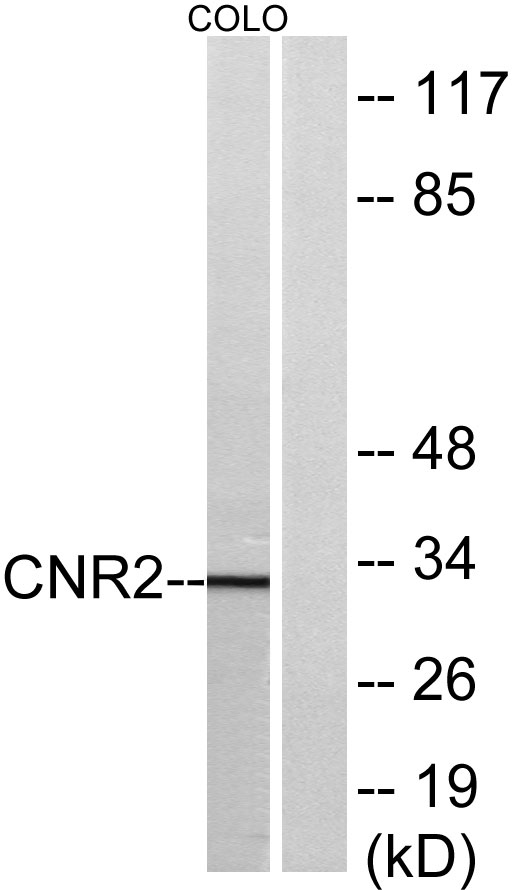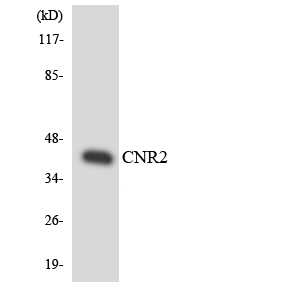CB2 Polyclonal Antibody
- Catalog No.:YT0688
- Applications:WB;IF;ELISA
- Reactivity:Human;Rat;Mouse;
- Target:
- CB2
- Fields:
- >>Neuroactive ligand-receptor interaction
- Gene Name:
- CNR2
- Protein Name:
- Cannabinoid receptor 2
- Human Gene Id:
- 1269
- Human Swiss Prot No:
- P34972
- Mouse Swiss Prot No:
- P47936
- Immunogen:
- The antiserum was produced against synthesized peptide derived from human CNR2. AA range:191-240
- Specificity:
- CB2 Polyclonal Antibody detects endogenous levels of CB2 protein.
- Formulation:
- Liquid in PBS containing 50% glycerol, 0.5% BSA and 0.02% sodium azide.
- Source:
- Polyclonal, Rabbit,IgG
- Dilution:
- WB 1:500 - 1:2000. IF 1:200 - 1:1000. ELISA: 1:5000. Not yet tested in other applications.
- Purification:
- The antibody was affinity-purified from rabbit antiserum by affinity-chromatography using epitope-specific immunogen.
- Concentration:
- 1 mg/ml
- Storage Stability:
- -15°C to -25°C/1 year(Do not lower than -25°C)
- Other Name:
- CNR2;Cannabinoid receptor 2;CB-2;CB2;hCB2;CX5
- Observed Band(KD):
- 33kD
- Background:
- The cannabinoid delta-9-tetrahydrocannabinol is the principal psychoactive ingredient of marijuana. The proteins encoded by this gene and the cannabinoid receptor 1 (brain) (CNR1) gene have the characteristics of a guanine nucleotide-binding protein (G-protein)-coupled receptor for cannabinoids. They inhibit adenylate cyclase activity in a dose-dependent, stereoselective, and pertussis toxin-sensitive manner. These proteins have been found to be involved in the cannabinoid-induced CNS effects (including alterations in mood and cognition) experienced by users of marijuana. The cannabinoid receptors are members of family 1 of the G-protein-coupled receptors. [provided by RefSeq, Jul 2008],
- Function:
- disease:Allelic variation at the CB2 locus is associated to genetic predisposition for depression in Japanese populations.,function:Heterotrimeric G protein-coupled receptor for endocannabinoid 2-arachidonoylglycerol mediating inhibition of adenylate cyclase. May function in inflammatory response, nociceptive transmission and bone homeostasis.,PTM:Constitutively phosphorylated on Ser-352; phosphorylation increases cell internalization and desensitizes the receptor.,similarity:Belongs to the G-protein coupled receptor 1 family.,subcellular location:Localizes to apical dendrite of pyramidal neurons.,tissue specificity:Preferentially expressed in cells of the immune system with higher expression in B cells and NK cells (at protein level). Expressed in skin in suprabasal layers and hair follicles (at protein level). Highly expressed in tonsil and to a lower extent in spleen, peripheral blood
- Subcellular Location:
- Cell membrane; Multi-pass membrane protein. Cell projection, dendrite . Perikaryon . Localizes to apical dendrite of pyramidal neurons. .
- Expression:
- Preferentially expressed in cells of the immune system with higher expression in B-cells and NK cells (at protein level). Expressed in skin in suprabasal layers and hair follicles (at protein level). Highly expressed in tonsil and to a lower extent in spleen, peripheral blood mononuclear cells, and thymus. PubMed:14657172 could not detect expression in normal brain. Expressed in brain by perivascular microglial cells and dorsal root ganglion sensory neurons (at protein level). Two isoforms are produced by alternative promoter usage and differ only in the 5' UTR: isoform CB2A is observed predominantly in testis with some expression in brain, while isoform CB2B is predominant in spleen and leukocytes.
- June 19-2018
- WESTERN IMMUNOBLOTTING PROTOCOL
- June 19-2018
- IMMUNOHISTOCHEMISTRY-PARAFFIN PROTOCOL
- June 19-2018
- IMMUNOFLUORESCENCE PROTOCOL
- September 08-2020
- FLOW-CYTOMEYRT-PROTOCOL
- May 20-2022
- Cell-Based ELISA│解您多样本WB检测之困扰
- July 13-2018
- CELL-BASED-ELISA-PROTOCOL-FOR-ACETYL-PROTEIN
- July 13-2018
- CELL-BASED-ELISA-PROTOCOL-FOR-PHOSPHO-PROTEIN
- July 13-2018
- Antibody-FAQs
- Products Images

- Western Blot analysis of various cells using CB2 Polyclonal Antibody

- Western blot analysis of lysates from COLO205 cells, using CNR2 Antibody. The lane on the right is blocked with the synthesized peptide.

- Western blot analysis of the lysates from HT-29 cells using CNR2 antibody.



